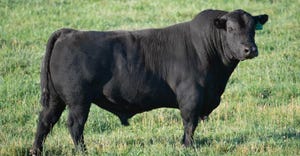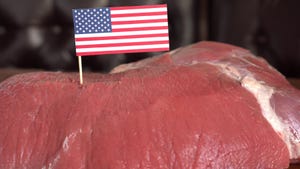Investor reveals marketing strategies for alternative proteins
An investor in plant-based and petri-dish proteins shares a behind-the-scenes look of these emerging proteins with a crowd of ranchers.
January 27, 2020

Over the weekend, I spoke at the Cornbelt Cow-Calf Conference & KIIC Farm Show in Ottumwa, Iowa. The event was attended by nearly 1,000 cattlemen and women from the region.
The program agenda included speakers who presented on topics including the latest in IVF technology, agricultural advocacy, farming with the family, managing toxic tall fescue, building soil health with cattle, the regulatory outlook of CBD and ways to add meat goats to cattle pastures for additional income opportunities.
These were all fantastic topics; however, of particular interest was the discussions on plant-based and petri-dish proteins.
Commonly referred to around here as “fake meats,” these emerging proteins have certainly made waves in the last year or so. I think most beef industry folks I’ve visited with agree we welcome the competition. The world needs protein, and this is another choice for the consumers.
However, what we don’t welcome is these companies slandering our products and stealing our name in order to cash in on consumer fears in their goal to disrupt the food sector with the next billion-dollar faux food company.
Before this, we could only speculate what the intentions of these companies actually are. After all, how many of us have had the opportunity to ask questions of these investors?
How exciting for us then to have the chance to listen to the source and hear how they intend to gain marketshare for the new, trendy products!
Speaking at the Cornbelt Cow-Calf Conference was Tom Mastrobuoni, Formerly the Chief Financial Advisor for Tyson, the corporate venture capital arm of Tyson Foods, Mastrobuoni now works independently from his home base in New Jersey as an investor of these emerging companies specializing in plant-based and petri-dish proteins.
I introduced myself before my talk and prepared him that I would more than likely make a few comments about the slanderous route the fake meat companies have taken as they battle for attention from consumers. He took it graciously, and we moved on to discuss more important matters - our kids, family, travels, etc.
Once my speech was over, Mastrobuoni took the stage, and for two hours, we got to learn the ins and outs of these companies. While I’m sure he turned down the rhetoric that he might use in a company pitch to a potential partnering investor, it was interesting to hear how he compared and contrasted the different protein sources from the lens of a venture capitalist and consumer, who also has vast experiencing in the packing industry.
Here are a few take-home messages from his talk:
1. Yes, they are playing on people’s emotions.
Mastrobuoni explained that consumers are becoming increasingly focused on issues like health and wellness, food safety, animal welfare, environmental sustainability and various restrictive diets. (Yes, we can agree on that.)
He argued that because the perception is that meat production falls short on so many of these issues and because consumers make emotional decisions, it only makes sense for these companies to capitalize on those emotions and create a business around it.
“Plant-based meats were a trend or a fad, but now they are becoming actual, viable businesses,” he said. “At the end of the day, consumers want options. When you go down the cereal aisle, there’s 60,000 options. It’s the same way with protein.
2. There are three phases to making these products really click with consumers.
Phase one focused on an effort to make the protein itself. Phase two centers around taste. And phase three is geared toward dialing in that taste while also parroting the price and nutritional profile of beef.
“We need to get the nutrition more in line with beef,” he said.
3. Meat still has the edge on whole muscle cuts.
As these companies focus on creating a tasty, nutritional, budget-friendly ground meat product, Mastrobuoni says progress being made on 3D protein production (on the lab meat side) has been slow.
“Currently, we can only grow chicken, pork and beef in two dimensions,” he said. “We can’t grow three dimensions to make things like steak. And the fat, where the sizzle, aroma and flavor comes from is difficult to achieve, so the product is very lean. Harvard is working on culturing fat cells now.”
4. Lab meats may be more efficient.
No, there hasn’t been any studies done to show the natural resources needed to grow meat in a lab on a large scale; however, Mastrobuoni sees the potential for lab meats meeting the protein needs for people in developing countries around the world.
“The draw is the efficiency of the system,” he said. “It takes awhile to produce a beef animal, so this is being looked at as a much more efficient option. There are major investors playing in this space, so they will make progress, but how quickly can they get there? A kilo of beef is $3,000 dollars. As cool and fascinating as these products may be, if you can’t sell it at a price parody, then nobody will buy it.”
5. There’s still the ick factor.
“Consumers buy what they are comfortable with, and there is an ick factor to these new products,” he said. “To ask a consumer to make an informed decision is asking a lot. We don’t expect these lab meats to take off in grocery stores or in fine dining establishments in the U.S. We are thinking more globally. In places where there are no roads, no supply chains, no packing, etc., we can instead have distribution centers where these products are made nearby people who need the protein and sold at a set price. It makes a lot of sense when you look at it this way.”
6. Each company has a different ethos/values for their “why.”
Money aside, these companies have different values for what propels them to move their businesses forward. Ethan Brown of Beyond Meat is passionate about climate change, while Pat Brown of Impossible Foods openly says he wants to eliminate animal agriculture.
And while some want to scale to feed the masses and envision large meat breweries that will manufacture these products, a company out of Israel envisions K-cup style meat production systems, where you could grow a serving size of meat from cells in the comfort of your own home.
Then there’s companies like Chipotle, he said, who simply won’t sell these alternative proteins because it doesn’t match their brand and their company values of “natural” ingredients.
7. Beef will still be favored by consumers.
A rancher in the crowd asked Mastrobuoni, “How will this impact the beef industry?”
He replied, “Global demand for protein continues to increase. Barring some sort of tragic epidemic that wipes livestock producers out, there will be opportunities for meat producers to sell to consumers. The speed of growth for plant-based burgers will slow down, and traditional will always outcompete.”
8. Opportunities for producers exist.
If farmers want to be part of the growth of these plant-based companies, they should reach out to the entrepreneurs who have founded these start-ups and ask to partner with them, he said.
The ingredients side of the businesses are where the opportunities are, so he suggested that traditional row-crop farmers consider these partnerships and grow things like yellow peas to meet the high demand for these protein sources for the plant-based companies.
9. The billion-dollar unicorn.
Mastrobuoni shared the story of how Blockbuster had the opportunity to buy the mega-successful Netflix. They passed, and Blockbuster is now a thing of the past.
Likewise, in the food space, he said everybody is trying to find the next Netflix.
“They are all hunting for unicorns — the billion-dollar businesses that aren’t publicly traded. Nobody wants to miss out on the opportunity to find the next big thing.”
And as these companies fight for market share, the mudslinging is now turning toward each other.
“There is a lot of bashing with claims that some products have eight or nine ingredient panels instead of 33,” he said. “I expect to see some consolidation with many of these companies, and the field of players getting slimmed down a bit.”
10. Can beef make a comeback with consumers despite the negative press?
In the Q&A section, I asked him, “What can producers do to make beef look like a solid investment again to folks like you?”
He said, “I go into the meat case, and I have no idea how to prepare the cuts of beef I see. It’s confusing. If only the beef industry would invest in an app or something that would tell me how to cook these different cuts.”
I replied, “Hey, we do have that! Let me tell you about ‘Chuck Knows Beef!’”
I hope this little recap gives you some insights from an investor’s perspective on plant-based meats. Love it or leave it, this was incredible information to hear from the horse’s mouth, and with this knowledge comes a better opportunity for beef producers to learn and pivot in our own strategies to market our product.
We’ve got to make cattle cool again and beef a retro product that consumers can’t wait to get a hold of! If we can’t do that, we’ll see these beyonds and the impossibles really take off. Frankly, we’ve got a better product and a better, but if our consumer doesn’t know it, what good does it do us?
The opinions of Amanda Radke are not necessarily those of beefmagazine.com or Farm Progress.
About the Author(s)
You May Also Like



.png?width=300&auto=webp&quality=80&disable=upscale)

